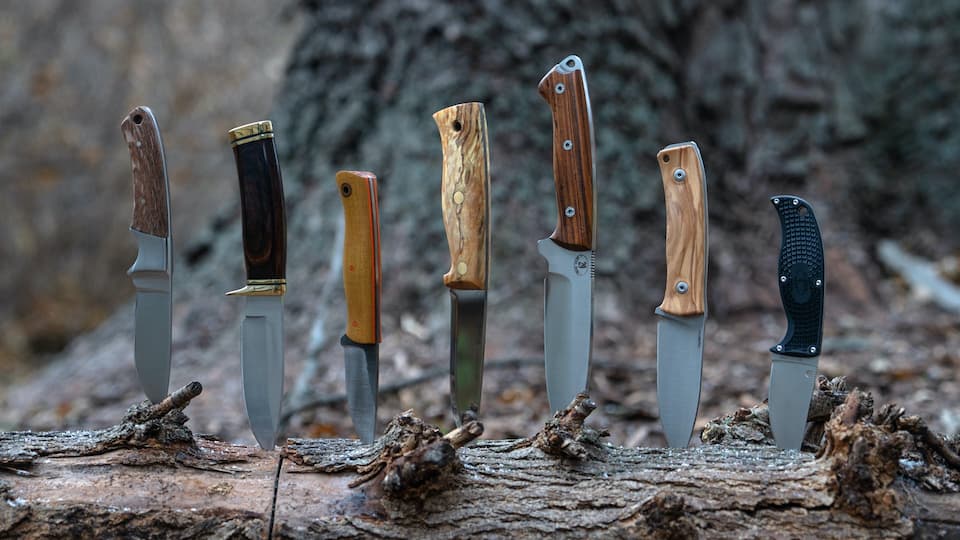The range of modern hunting equipment available now on the market sure contributes to a better hunting experience. However, there is one traditional tool that all hunters still rely on – a quality knife. Aside from being an essential part of the activity, a hunting knife can also be used for many other things out the field, the reason why many hunters find them the most important thing to carry with them.
More serious hunters like to carry more than one knife with them to serve different purposes, but this will depend on what you’re hunting and the specifics of how you like to do it. Whether it’s a multi-purpose tool, a hunting skinning knife or a hunting cutting knife, chances are you’ll always need one there.
Learning the basics about different types of hunting knives and how to get the best use out of them is the main thing one should learn before entering the hunting game. Understanding them completely will help you achieve a much more successful outing.
How Hunting Knives Differ From Each Other

Different types of hunting knives exist and they’ve been designed to work with the hunted animal. You’ll need a knife to allow you to remove the skin and fur, take the internal organs out of the carcass and even cut through bone and other matter before you take it with you. To be able to perform each of these tasks properly, you’ll a dedicated tool that’s not simply a multipurpose blade meant for anything.
Because you’ll be working with animal carcasses and other harsh circumstances, you’ll need something heavy-duty, super sharp and easy to maneuver. The knife also needs to be reliable because you’ll be travelling with whatever is in your kit and nothing else. The blade should be long and thick to cut through the game, but also have a tip to allow you to perform precise cuts as needed. That said, choosing a dedicated hunting knife is essential if you want to be able to do things the right way.
Types of Hunting Knives
You will want to have at least a couple of different knives in your arsenal to meet the many needs of the hunt.
Hunting Skinning Knife

After you hunt the animal, the first thing you’ll need to do is take off its skin. Note that this is a very crucial process that requires a steady hand and a certain skill set. Some practice will help you master it, but having a hunting skinning knife can make the job a lot easier. Short and thin, this particular knife has an extremely sharp blade to skin off the animal without damaging the flesh or the tissue. Some may also feature a small curve for increased control.
Nowadays you can find skinning knives in both fixed-blade and folding designs. If you’ll be doing occasional skinning and slicing, then a folding model should be able to meet your needs. Compact in design, folding knives offer the benefits of portability and versatility. On the other hand, if you’ll skinning or butchering a number of animals, then you should consider investing in a fixed-blade sheath knife as it’s easier to clean, is usually easier to sharpen, and the blade itself tends to last longer. Fixed blade skinning knives are also better suited for producing a number of cuts.
You also need to consider that the knife is bound to get bloody or coated with the viscous membranes between an animal’s skin and flesh. The last thing you’ll want in these cases is to have your slippery knife slide out of your hand. So, make sure the handle of the knife has some texture. Synthetic materials with plenty of textures are a good choice but bone and wood handles also have natural gripping abilities. No matter what kind of knife you choose, make sure the handles fit your hand well. If the handle of the knife is too small or too large for your hand, this will make skinning and cutting chores more tiring than they need to be.
Gutting

Gutting is a term used to refer to the process of removing the organs of an animal. Let’s take a deer as an example. In order to dress it, you need first to remove its organs to preserve it while it’s still warm and fresh. In this case, a gutting knife that is designed specifically for this purpose is a must. You’ll see most of these knives featuring a gut hook in order to simplify the process.
Boning
A boning knife has a very long, slim blade with a solid handle for a firm grip. Having a boning knife with you when hunting is a blessing as it makes the process of deboning the animal much easier and more effective. While the blade may look a bit flimsy, it can do wonders.

While there are other types of hunting knives, these are the main ones you’ll need. When shopping for your hunting knives, keep in mind that quality is key. Quality knives typically come with carbon steel or stainless steel blades, each of which has pros and cons. Carbon steel blades rust, so they need special treatment. Using the knife regularly is the best way to prevent rust from forming on the table, but the blade can also be coated to prevent it from rusting. Carbon steel blades tend to be easier to sharpen and remain sharp for longer than stainless steel blades. Stainless steel blades, on the other hand, are rust-resistant. This factor makes them quite popular with hunters who hunt in areas with rainy conditions. However stainless steel knives are more expensive than carbon steel knives and also more difficult to sharpen.
